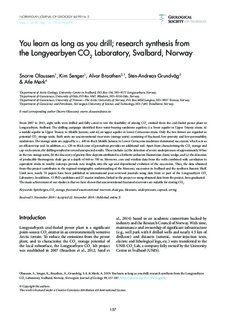| dc.contributor.author | Olaussen, Snorre | |
| dc.contributor.author | Senger, Kim | |
| dc.contributor.author | Braathen, Alvar | |
| dc.contributor.author | Grundvåg, Sten-Andreas | |
| dc.contributor.author | Mørk, Atle | |
| dc.date.accessioned | 2020-02-13T11:45:19Z | |
| dc.date.available | 2020-02-13T11:45:19Z | |
| dc.date.created | 2019-11-19T11:24:35Z | |
| dc.date.issued | 2019 | |
| dc.identifier.citation | Norwegian Journal of Geology. 2019, 99 (2), 157-187. | nb_NO |
| dc.identifier.issn | 2387-5844 | |
| dc.identifier.uri | http://hdl.handle.net/11250/2641518 | |
| dc.description.abstract | From 2007 to 2015, eight wells were drilled and fully cored to test the feasibility of storing CO2 emitted from the coal-fueled power plant in Longyearbyen, Svalbard. The drilling campaign identified three water-bearing sandstone aquifers; i) a lower aquifer in Upper Triassic strata; ii) a middle aquifer in Upper Triassic to Middle Jurassic; and iii) an upper aquifer in Lower Cretaceous strata. Only the two former are regarded as potential CO2 storage units. Both units are unconventional reservoirs (storage units) consisting of fractured, low-porosity and low-permeability sandstones. The storage units are capped by a c. 400 m-thick Middle Jurassic to Lower Cretaceous mudstone-dominated succession, which acts as an efficient top seal. In addition, a c. 120 m-thick zone of permafrost provides an additional seal. Apart from characterising the CO2 storage and cap-rock system, the drilling resulted in several unexpected results. These include: (a) the detection of severe underpressure of approximately 50 bar in the two storage units, (b) the discovery of gravity-flow deposits attributed to a hitherto unknown Hauterivian clastic wedge, and (c) the detection of producible thermogenic shale gas at a depth of 640 to 700 m. Moreover, core and wireline data from the wells combined with correlation to equivalent strata in nearby outcrops provide new insights into the age and depositional evolution of the succession. Thus, the data obtained from this project contributes to the regional stratigraphic understanding of the Mesozoic succession in Svalbard and the northern Barents Shelf. Until now, nearly 70 papers have been published in international peer-reviewed journals using data from or part of the Longyearbyen CO2 Laboratory. In addition, 13 PhD candidates and 27 master students, linked to the project or using obtained data from the project, have graduated. The main achievement of our studies is that we have shown that unconventional fractured reservoirs are suitable for storing CO2. | nb_NO |
| dc.language.iso | eng | nb_NO |
| dc.publisher | Norsk Geologisk Tidsskrift | nb_NO |
| dc.relation.uri | https://njg.geologi.no/component/fabrik/details/1/2218-2218 | |
| dc.rights | Navngivelse 4.0 Internasjonal | * |
| dc.rights.uri | http://creativecommons.org/licenses/by/4.0/deed.no | * |
| dc.title | You learn as long as you drill; research synthesis from the Longyearbyen CO2 Laboratory, Svalbard, Norway. | nb_NO |
| dc.type | Journal article | nb_NO |
| dc.type | Peer reviewed | nb_NO |
| dc.description.version | publishedVersion | nb_NO |
| dc.source.pagenumber | 157-187 | nb_NO |
| dc.source.volume | 99 | nb_NO |
| dc.source.journal | Norwegian Journal of Geology | nb_NO |
| dc.source.issue | 2 | nb_NO |
| dc.identifier.doi | https://dx.doi.org/10.17850/njg008 | |
| dc.identifier.cristin | 1749286 | |
| dc.relation.project | Norges forskningsråd: 228107 | nb_NO |
| dc.relation.project | Norges forskningsråd: 257579 | nb_NO |
| dc.description.localcode | © Copyright the authors. This work is licensed under a Creative Commons Attribution 4.0 International License. | nb_NO |
| cristin.unitcode | 194,64,90,0 | |
| cristin.unitname | Institutt for geovitenskap og petroleum | |
| cristin.ispublished | true | |
| cristin.fulltext | original | |
| cristin.qualitycode | 1 | |

